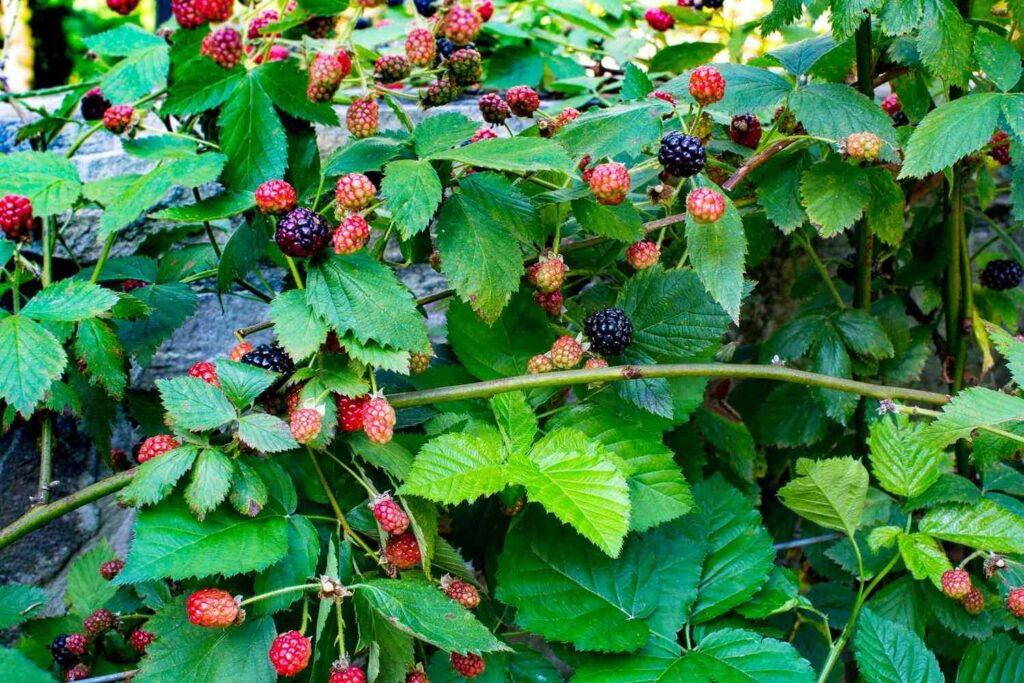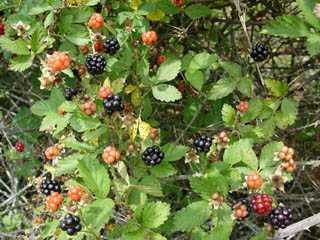
Right now in central Florida, the thornless blackberry canes are blooming—soft white petals opening like tiny invitations to bees. Soon, the green berries will blush red and then ripen into deep, sweet black. But what many gardeners don’t realize is that this humble bramble offers more than just a summer snack.
It’s a beautiful, medicinal powerhouse—leaf to fruit.
A Berry Native to Many Places
Blackberries (Rubus spp.) are native to large swaths of North America, Europe, and Asia. In the U.S., wild blackberries thrive in forest edges, old fields, roadsides, and sunny thickets. In Florida, you can find native species like Rubus trivialis (Southern Dewberry), which often sprawl along sandy soils.

Rubus trivialis (Southern Dewberry)
Though wild blackberry canes are famously thorny, many garden cultivars (like ‘Navaho’ or ‘Apache’) are thornless and surprisingly well-behaved. They grow upright, require little pampering, and reward you with fruit from May through July, depending on the variety.
Medicinal Uses of Blackberry Leaves
While most people grow blackberries for their sweet summer fruit, the leaves are equally valuable—especially in herbal medicine.
Blackberry leaves contain tannins, flavonoids, vitamin C, and ellagic acid, making them useful for:
Digestive support: Astringent and anti-inflammatory, blackberry leaf tea can help soothe diarrhea and inflammation of the gut lining.
Oral health: Gargling with a blackberry leaf infusion can reduce mouth sores and inflamed gums.
Skin care: The leaf infusion can be used in compresses for minor wounds, rashes, or skin irritations.
Clinical studies have found that blackberry leaf extract has significant antioxidant, antimicrobial, and anti-inflammatory properties:
A 2011 study published in Phytotherapy Research confirmed its antibacterial effects against oral pathogens, supporting traditional use in treating mouth and throat conditions.
A 2020 review in the Journal of Ethnopharmacology found that Rubus leaves have promising anti-diabetic, anti-ulcer, and antiviral potential as well.
Note: Always consult a qualified healthcare provider before using herbs medicinally, especially if pregnant, nursing, or on medication.
Fruit Benefits Go Beyond Flavor
Blackberries are rich in vitamins A, C, E, and K, as well as anthocyanins, the antioxidant pigments that give them their deep color. Eating blackberries regularly may help:
Reduce oxidative stress
Support heart health
Improve cognitive function
Lower inflammation
And of course, they taste like summer—especially eaten fresh from the vine, still warm from the sun.
Growing Thornless Blackberries in the Home Garden
If you’re in USDA zones 6–10, thornless blackberries can thrive with just a few simple needs:
Sunlight: Full sun (6–8 hours/day) for best fruit production
Soil: Slightly acidic, well-drained soil (amend with compost)
Support: A trellis or fence for upright varieties
Water: Consistent watering, especially while fruiting
Pruning: Cut back floricanes (2nd year fruiting stems) after harvest to promote new growth
Final Thought: A Garden That Nourishes Every Part
There’s something deeply satisfying about growing a plant that feeds both body and soul. Thornless blackberries give you beauty, bees, berries, and medicine—all without drawing blood.
So if you’ve ever considered planting a few canes, let this be your nudge. You won’t just be growing fruit. You’ll be growing a tradition, rooted in centuries of wild healing.
And if you already grow them? Pour yourself a cup of blackberry leaf tea, step into your garden, and watch the blossoms bloom.
